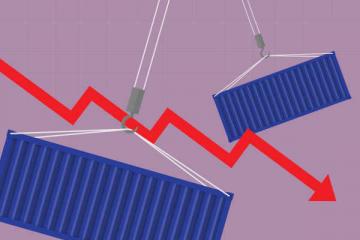Irrespective of mode, rates will be escalating, with carriers controlling capacity and exercising leverage like never before. Given the shortage of manpower and labor pools across the spectrum of global supply chan, managers will be struggling
Industry analysts advise our readers to expect a steady escalation of rates and expenses. The good news? A different mindset may transform our transport culture and strategic planning.
Rate Forecasts are always challenging for the rail and intermodal sector, says Jason Kuehn, vice president of the consultancy Oliver Wyman. But this one feels more difficult than most.
“Rail and intermodal pricing were very strong this year,” he says. “Demand was robust this year and truck shortages and supply chain congestion slowed things downing creating a perfect storm for logistics shortages.”
But with all things that boom, there usually follows a bust, Kuen maintains. Inflation is high and consumer sentiment is declining. He adds that after a strong year and an all-out back in-person Holiday season, consumer spending may see a pull-back in 2022.
“Grocery, gas, restaurant prices – and soon – utility bills are all going to be higher tugging at the consumer wallets,” says Kuen. “Input expenses are also soaring for iron and steel scrap, finished steel, oil and natural gas, and wage rates. It seems unlikely that people can absorb these increases without some retrenchment in demand. It has been a long time since we have seen 5+% inflation rates.”
He notes that until intermodal delivers a more reliable service product it will continue to be whipsawed by the trucking market. Intermodal rates as usual will lag general trucking trends, creating demand as rates rise, but suffering faster defections when truck rates fall.
“A restocking of inventory in the face of falling demand will favor intermodal for several months as transit time and reliability will be less of a factor until demand and inventory levels reach a new equilibrium,” says Kuen.
Finally, labor shortages are hitting suppliers, carriers, and receivers across the board – the pressures from wages and high diesel prices are likely to keep truck rates high even as demand eases. Supply chain congestion is likely to keep equipment constrained through much of 2022.
“These factors taken together argue for rates to be flat to up, even if we see some easing in demand. Once prices rise they tend to be sticky and not come down quickly,” concludes Kuen.
SC
MR

Latest Supply Chain News
- Few executives believe their supply chains can respond quickly to disruptions
- Technology’s role in mending supply chain fragility after recent disruptions
- Tech investments bring revenue increases, survey finds
- Survey reveals strategies for addressing supply chain, logistics labor shortages
- Israel, Ukraine aid package to increase pressure on aerospace and defense supply chains
- More News
Latest Podcast

 Explore
Explore
Business Management News
- Few executives believe their supply chains can respond quickly to disruptions
- Technology’s role in mending supply chain fragility after recent disruptions
- Survey reveals strategies for addressing supply chain, logistics labor shortages
- How CPG brands can deliver on supplier diversity promises
- How S&OP provides the answer to in-demand products
- AI, virtual reality is bringing experiential learning into the modern age
- More Business Management
Latest Business Management Resources

Subscribe

Supply Chain Management Review delivers the best industry content.

Editors’ Picks





